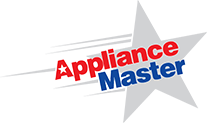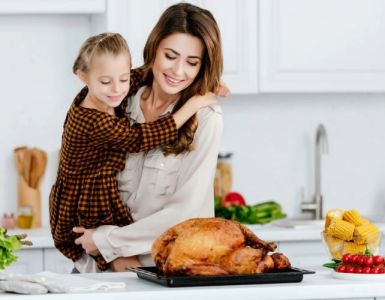Here’s a refresher on the different types of cooking appliances and keeping them clean. If your oven or burners heat unevenly, or there’s a delayed ignition, call Appliance Master for service before you have a bigger problem!
Electric Cooktop
An electric cooktop can have coiled burners or a smooth surface.
Cleaning:
Coiled burners will typically burn off any spills. The drip bowls underneath can be easily taken out for cleaning. For larger spills, wait until it’s cool, then learn how your cooktop “opens”; most models are hinged and open just like a car hood. This will allow you to clean underneath the burners.
Smooth surface cooktops can be easily wiped clean.
Check your manual for recommended cleaning products.
Electric Oven
In an electric oven, the element is at the top of the cavity. Use the middle rack for best results. Use the top rack when you want to broil. The bottom of the oven will be cooler and take more time to bake.
Cleaning:
Oven racks can be removed and cleaned as needed. Spills should be wiped up as soon as the oven has cooled to avoid smoking and burning during the next use.
When using a chemical oven cleaner, follow the directions very carefully; the fumes are noxious and the chemical is caustic.
If you have a self-cleaning oven, try to scrape up and remove any residue from the bottom of the oven cavity before you start.
Follow the manufacturer’s instructions and don’t try to force the oven door open until the cycle is completely finished.
Gas Cooktop
A gas cooktop can have 4-6 burners and may have a grill or griddle.
Cleaning:
Spills on grates and burners will usually burn off or you can scrape the residue off. Larger spills should be cleaned as soon as the affected area has cooled off. If the burner orifices get clogged, you’ll notice uneven flames.
To unclog orifices, gently poke a wooden toothpick through. Use of a metal tool, such as a skewer or paper clip, should be done with care.
*Has your burner ever started clicking by itself and doesn’t stop? Either a spill or too much cleaning solution has gotten the spark igniter wet.
Wipe up any excess liquid. Unless the spark igniter is damaged, it will eventually stop clicking.
Gas Oven
In a gas oven, there are vents which allow the heated air to flow into the oven cavity. This can cause uneven temperatures throughout the oven.
If your gas oven cooks unevenly, try putting a pizza stone on the bottom rack. It will hold heat and keep the temperature from fluctuating as much.
Use the middle rack for best results.
Cleaning:
Oven racks can be removed and cleaned as needed. Spills should be wiped up as soon as the oven has cooled to avoid smoking and burning during the next use.
Do not line the bottom of the cavity with foil; it may cover the vents which let the heat from the burner into the oven cavity.
When using a chemical oven cleaner, follow the directions very carefully; the fumes are noxious and the chemical is caustic.
If you have a self-cleaning oven, try to scrape up and remove any residue from the bottom of the oven cavity before you start.
Follow the manufacturer’s instructions and don’t try to force the oven door open until the cycle is completely finished.
Self Cleaning Ovens
Self-cleaning ovens use extremely high heat (800-900 degrees) to turn debris and residue into a white ash that an easily be wiped up after the cycle is complete.
Before you start the cycle, take the racks out and never try to force the door open until the cycle is finished.
Recipes
Here is a fun and easy recipe for Dutch Baby Pancakes
Imagine a pancake, a crepe, and a popover — all in one giant skillet. Set out different toppings (like fruit, jam, hazelnut spread, honey, and peanut butter) so everyone can create their own amazing breakfast!
Ingredients
| Refrigerated: 2 Eggs, large Dairy: 2 tbsp. Butter, unsalted 1/2 cup Whole or 2% Milk | Baking & Spices: 1/2 cup All-Purpose Flour 2 tbsp. Granulated Sugar 1/2 tsp. Kosher Salt 1 Powdered Sugar 1 tsp Vanilla Extract |
Instructions
- Blend the batter: Place the flour, milk, eggs, sugar, vanilla, and salt in a blender or food processor fitted with the blade attachment. Blend for 10 seconds, scrape down the sides, and then blend for another 10 seconds. The batter will be quite loose.
- Rest the batter: Leave the batter in the blender and set aside to rest 20 to 25 minutes. This gives the flour time to absorb the liquid.
- Heat the pan and oven: Meanwhile, place a 9 to 10-inch oven-safe skillet on the middle rack of the oven and remove any racks above it. Heat the oven to 425°F.
- Melt the butter: When ready to make the pancake, remove the skillet from the oven using oven mitts and place it on top of the stove. Add the butter and swirl the pan to melt the butter and coat the bottom and sides of the pan.
- Add the batter: Pour the batter on top of the butter. Tilt the pan if needed so that the batter runs evenly to all sides. Place the skillet in the oven.
- Bake the Dutch baby: Bake until the Dutch baby is puffed, lightly browned across the top, and darker brown on the sides and edges, 15 to 20 minutes.
- Serve while hot: You can either serve from the pan or transfer the Dutch baby to a serving platter. Dust with powdered sugar. Cut into wedges and serve with maple syrup or jam.
Recipe
Fruit-filled Dutch baby: Arrange fruits like blueberries, raspberries, or sliced peaches over the bottom of the skillet and then pour the batter over top. (Scattering fruit on top of the batter will keep it from rising as impressively.)








Add comment